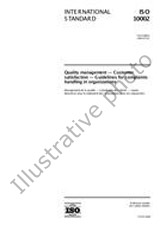We need your consent to use the individual data so that you can see information about your interests, among other things. Click "OK" to give your consent.

ISO 9599:2015-ed.2.0
Copper, lead, zinc and nickel sulfide concentrates — Determination of hygroscopic moisture content of the analysis sample — Gravimetric method
Automatically translated name:
Copper, lead, zinc and nickel sulfide concentrates -- Determination of hygroscopic moisture content of the analysis sample -- Gravimetric method
STANDARD published on 29.9.2015
The information about the standard:
Designation standards: ISO 9599:2015-ed.2.0
Publication date standards: 29.9.2015
SKU: NS-618188
The number of pages: 6
Approximate weight : 18 g (0.04 lbs)
Country: International technical standard
Category: Technical standards ISO
The category - similar standards:
Annotation of standard text ISO 9599:2015-ed.2.0 :
Description / Abstract: ISO 9599:2015 specifies a gravimetric loss-in-mass method for the determination of the hygroscopic moisture content in analysis samples of copper, lead, zinc, and nickel sulfide concentrates. The method is applicable to copper, lead, zinc, and nickel sulfide concentrates free from volatile organic flotation reagents, for example kerosene, and with hygroscopic moisture contents between 0,05 % (m/m) and 2 % (m/m). The hygroscopic moisture content is used to correct the analysis results from the equilibrated moisture level to the dry basis. NOTE The result of the determination of hygroscopic moisture content using this International Standard should not be reported as part of the analysis of a concentrate sample. Whenever the bulk moisture content of a commercial shipment of concentrate is required, ISO 10251 should be used. The determination of hygroscopic moisture content and the determination of bulk moisture content are connected with each other. In both determinations, the same state of dryness has to be achieved, in order to ascertain the correct metal content of a lot. This method is not applicable to sulfide concentrates that are susceptible to oxidation (see 6.3, note 2). Annex A sets out a modified procedure, which can be used for sulfide concentrates that are susceptible to oxidation.
We recommend:
Technical standards updating
Do you want to make sure you use only the valid technical standards?
We can offer you a solution which will provide you a monthly overview concerning the updating of standards which you use.
Would you like to know more? Look at this page.



 Cookies
Cookies
